|
|
Post by 4real on Jan 4, 2012 23:07:21 GMT -5
No....left without touching it over lunch...all the problems still exist...grrr
Not sure if you guys have quite got the 'problem' or symptoms.
There is no noise on the piezo side of things.
There is still 'static' like sounds when turning the volume control.
If the dark switch is engaged this is worse with an almighty 'thump' as if you plugged the guitar into a live amp sound, when the volume is turned to max and only in that turning...not in operation.
So, only in moving the volume control, worse to hazardous when the dark switch is in use.
There is no noise from activating the dark switch or any other, despite these faults.
...
Very much appreciate the brains trust, but I am not sure that these things are really addressing teh 'problem'.
The dark switch should not be that 'exotic' it is just a tone control on max. I am not familiar with active guitars enough, but I am sure they can use tone controls without this effect.
It is of some suspicion that the dark switch activates a cap directly between ground and signal and that the ground is 'live' in an active guitar...still...hmmm
And then, when switched out, there is still this unacceptable though much less invasive 'crackling' and there is no cap in circuit at all there.
...
while typing, tested a 'hunch' in order to offer more clues...don't know if this will help.
If I turn the blend to full piezo, there is still the 'static' on the volume control (dark or no engaged). With the dark engaged, it is only when you get to complete mag ( extreme of blend pot) that you get the 'thump' on the volume pot...still the static, but not the worst of it.
I also have dual outputs, so have changed them, leads, amps, etc...
|
|
|
|
Post by 4real on Jan 4, 2012 23:47:28 GMT -5
Ok, more 'clues' and partial solution...
I got a 1K trim pota nd added this to the cap on the dark switch...so like a normal 'tone control'. This seems to have stopped the 'thump' though not the 'static' through the volume's travel.
Now, why this might be is still a mystery...after all, if the trim pot is turned all the way, there is no resistance is there? regardless seems to have helped.
I also took all the grounds that were connected to the side of the switch as a 'star ground' to themselves and took a single wire from that to the side of the switch and taped it up nice and eat. This should not have 'solved' anything and don't think it i did, but makes it neater and easier to work on.
My first instict was ta add a small ohm resistor to the mag out of the blend, obviously then it would not get to the 'zero resistance' that is a requirement of the thump...but then, now it would appear to have disappeared.
So...clue, partial solution? At least it seems to have removed the 'danger' of the thump, just a nuiesence volume control that is relatively unusable if it makes noise moving it...hmmm...but better.
Of course, I was sure that it had improved before and hadn't, so will leave it for a bit and see if things might return, but seems hopeful and now the 'dark switch' is a little adjustable if one can be bothered pulling everything out to adjust things LOL.
|
|
|
|
Post by 4real on Jan 5, 2012 3:02:04 GMT -5
last call for suggestions, will put it back together tomorrow...the 'thump' appears to have gone and the 'scratchiness' is fairly minimal...still like to 'fix' this but can't have tinker interminably, but it would be interesting to know why and how this stuff fixed anything...it is possible it could happen again. I will leave it to the morning and if it tests ok, it will go back in again!
thanks again for the patience with all this, much appreciated.
|
|
|
|
Post by JohnH on Jan 5, 2012 3:44:56 GMT -5
Sorry but no further inspirations have come to mind. I probably still dont have a proper appreciation of what the symptoms are and particularly when they occur and when they dont occur, never mind the cause of them - and thats despite your best descriptions of them!. Im happy to read any further descriptions, or listen to sound samples of symptoms. But they seem to have lagely gone away at this time.
The bit I suspect if any is the way the piezo box is grounded or supplying power to the rest of the circuit,
cheers
John
|
|
|
|
Post by 4real on Jan 5, 2012 4:24:34 GMT -5
Yes, thanks john and co...LOL...a few mysteries there and I too suspect the power supply in some way from what you guys have been saying. Cant think why and after all it was not always happening nor is the piezo itself ever affected.
The 'scratchiness' is far slighter than it was...at least last I tested it...so will check in the morning and then put it back again, at least I know how to get it in and out now.
Why my adding a trim pot should help I am not sure, plus even when turned to zero it affects it. I just hasd a feeling that I should at least disconnect that cap and see if it helped (it did) and if a resistor there might help. I was thinking of adding a small one to the blend so it never goes to 'zero' as well but does not seem necessary now.
As far as I can tell, the power is connected directly to the battery itself. The tuner goes into sleep mode though and works regardless of the thing being plugged in, so a little odd there. However, the tuner is not on nor makes any difference to these things...but there might be something there in that it must be able to access power to do this trick.
It is a useful feature, tuning when acoustic or when the volume turned to zero...
Ok, well if anything comes to mind...thanks again, I suspect there will be more some time...now, where did I put that volume pedal...hmmm...rather an un-scratchy pot.
You don't think it could be the pot itself?
|
|
|
|
Post by reTrEaD on Jan 5, 2012 12:24:54 GMT -5
You don't think it could be the pot itself? I don't think we can give the pot a completely clean bill of health, but my gut is telling me there is something very peculiar happening here. I can't reason out why the presence (or absence) of a cap directly across the pickup could cause the thumping. Or the worsening of the scratchiness. That cap is WAY upstream of the volume and the blender. The only mechanism I've been able to imagine is both DC on the output of the first buffer after the mag pickup and a poor ground connection to the first mag buffer. But you've already addressed those possibilities. I'm fairly certain there is something more that's wrong than just the pots, but I'm at a complete loss as to what that something is. |
|
|
|
Post by 4real on Jan 5, 2012 15:25:08 GMT -5
Yes, well it is a little odd...perhaps the scheme was a bit of a compromise of something. I'm tempted perhaps to re-build it completely with one of the earlier schemes perhaps with one of john's earlier schemes when I get the stew mack blend pot perhaps and a linear 100K for the volume control perhaps...though that is no guarantee
Testing this morning...the guitar is very quiet until on turns a knob.
There is a little scratchiness in the blend and a bit more in the volume control and as long as I don't move it, it's fine...but that kind of makes the controls a little...well, not quite superfluous, but takes away some potential there.
Not that impressed by the 'stiffness' of these pots either, both have plastic shafts and not built for this kind of control. But I tend to agree, I doubt it is the pots causing the noise.
So something of a mystery there...keep your thinking hats on...
...
However, incremental improvements for this weeks tinkering with it...since there is a high degree of collaboration on this and I'd like to promote not only the electronic tinkering of things, time to open up the camera and share the progress in pics below...
|
|
|
|
Post by JohnH on Jan 5, 2012 15:51:27 GMT -5
Any difference in current scratchiness between stereo and mono/blend settings?
In mono, do you get the same scratch from both outputs or just one output? and when blend is moved? and when volume is moved?
In stereo, same questions?
If you can step through each part of that carefully, it may be instructive, because going to stereo separates the two halves of the circuit, possibly revealing more of the location of the cause, if it is not just the pots themselves (ps, probably better to stop taking your guitars in the surf from now on)
John
|
|
|
|
Post by 4real on Jan 5, 2012 16:58:56 GMT -5
Ok...photos... 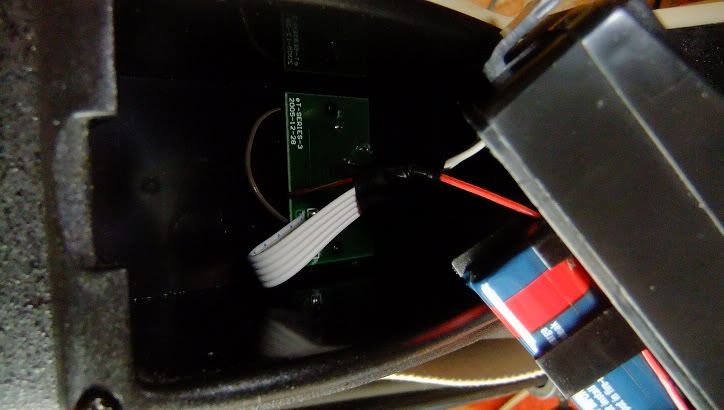 The battery compartment under the piezo controls, I added the red wire from the battery hot and the ground comes from the switch ground that is wired into it...string ground is connected that way as the piezo element is shielded and grounded to the bridge which is aluminium. 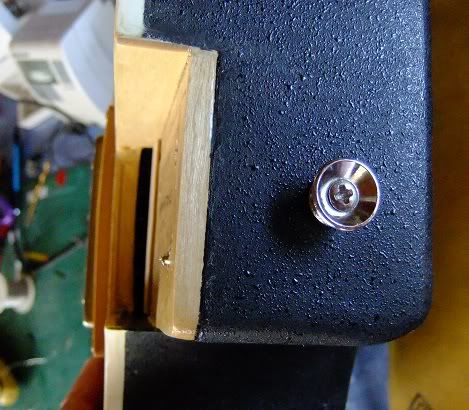 Shimming the neck...first attempt using a thin and wedge shaped bit of wood and double sided taped in place...looks C1 professional LOL...however... 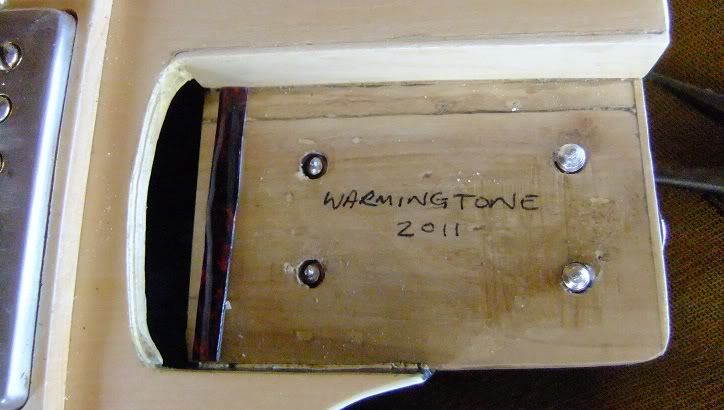 The alternative...this was a little low...so third attempt, moving this shim in front of the back screws seemed to take out just a touch of the slight 'ski jump' on the end of the neck and got the height right...  The end result is visually hardly noticeable, the neck join (fashioned from mouse traps if not come in from the start) is tight and very well supported, the fit a little longer than the strat and deep and supported completely on the upper side so very nice and solid but great upper string access for such a guitar, no heel, joins at the 15th fret, etc 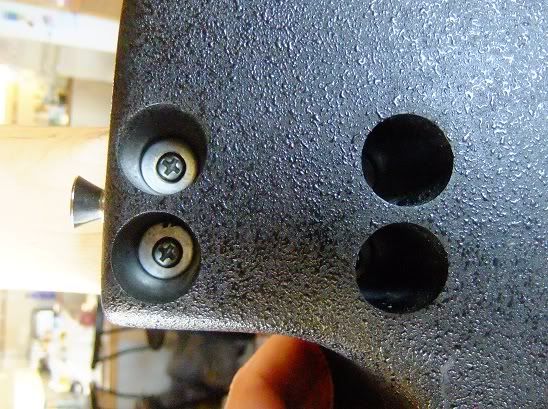 Here is the unusual bolt on neck. These holes are very deep so you can't see in there without a torch as in this pic. There is a fair thickness of plastic in the moulding between the neck and big washers, plus a decent amount of wood on top from the rebuilding of the neck joint epoxied on top. It shows the kind of 'texture' to the plastic body and curves in it. It is kind of like an ovation but with perhaps more vertical sides so it does not slip off the knee so much. I was able to add the strap button under the neck (will change later for strap locks) and balances well, but standing the 'bowl back' is unfortunately a similar shape to my own belly, now if they had a concave back to it...LOL...  Did I show this one, the final shim I believe. Only a tiny bit makes a big difference over the length of the neck. Remember that the end of the neck is lifted but the nut end moves down a lot more. This neck angles back a lot, notice the neck pocket rebuild has a fairly extreme back angle, about 5mm to 10mm over the whole of the pocket...poorly disguised with a sharpie pen I admit so that it kind of matches the binding size and is not noticeable under the neck and from a distance. A point in this is that with this extreme back angle, the screws needed to be very accurately drilled at the same angle to make this work...not straight down into the neck heal as with a fender. I used a drill press and some wood to angle the head to achieve this and worked out ok after quite a bit of 'fussing' but a very important part of the neck fitting. 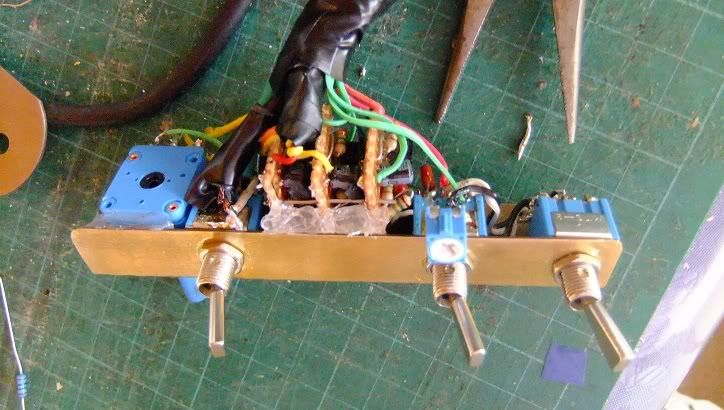 So, the end result on the volume plate. All those green wires are grounds and now go to a point taped to the main wiring and then to the dark switch. You can see I added a small trim pot (1K) to the switch for adjustment and mysteriously fixed the thump. 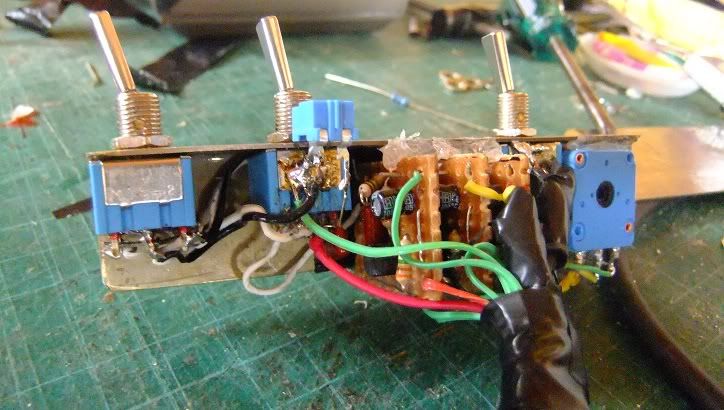 This gives a better impression. I re-installed all the switches to give the maximum extension now to make them easier to reach. 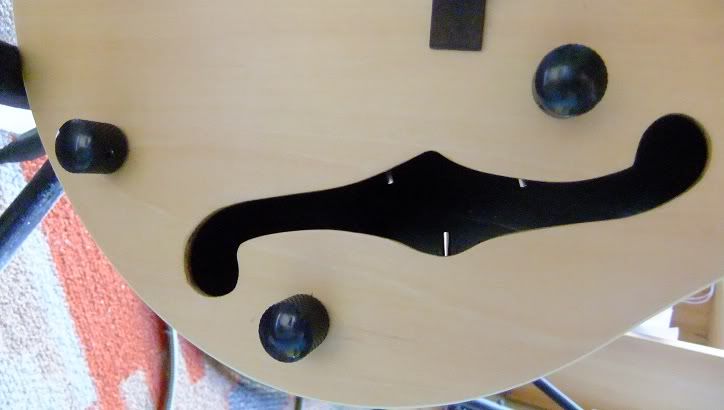 The end result is that they are a bit more obvious and easier to reach. The series/parallel switch near the volume control, the 'dark switch' further back and hidden the 'phase' switch. Below the blend stereo. 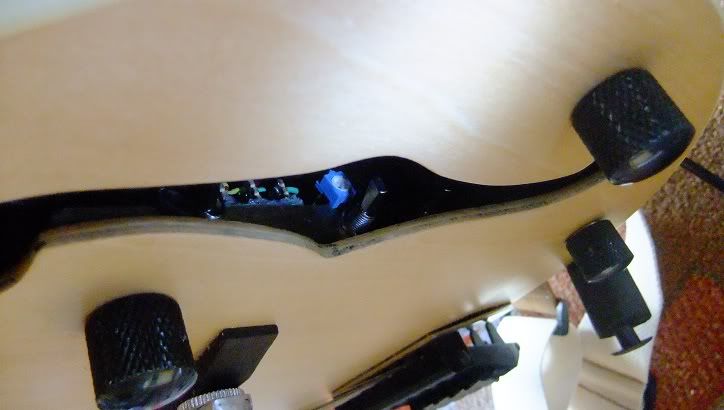 Using a torch, you can just see and reach that trim pot for teh dark control 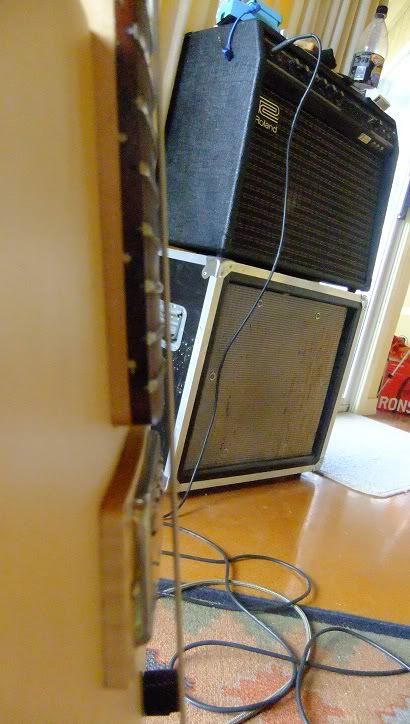 The end result on the action. The bridge still 'bottoms out' but that is where I want it and the action is fairly low at the nut end rising to this medium action. In the background you can see the roland GA60 amp sitting on top of my 15" extension bass box now brought out of retirement and sits by my front door as a place to put my keys. I've used this rig for decades and has been rock solid reliable. It is SS of course, but this kind of 'hi-fidelity' suits this guitar and the bass is quite stunning. The true sound suits the piezo side of things. In 'stereo', the mag goes to a fender HR deluxe and the combination of warmth from that is great and generally 10 feet apart, the sound really fills a room. I run it in the mono blend mode with the roland most of the time but I am interested in trying out a few effects to craft some unique sounds and will get around to recording it eventually where the stereo thing may well be very effective too. ... Playing it, this guitar is still surprising me... Other than the pot noise (grrr) the blend control is quite an amazing thing on this guitar and something to consider for other guitars perhaps, even without a piezo system. The series parallel switch is useful, it is not that much quieter, but a less thick sound and better matches the piezo volume and texture. Full HB is typically thick and creamy and a little louder...this can be blended out a little and that little extra brought up to bring the electric sound more forward and change the texture more dramatically. The "dark" switch is great for this guitar. engaged it is that classic muffled 'jazz box' sound. However, it is good not only for 'wes montgomery' impersonations. It also does the Danny Gatton trick of imitating the low end comping of a hammond organ (helps to put on some tremolo effect)... But wait, there is more...you can mix the straight piezo in and get a mix of this low end with the piezo, but if you turn the blend a bit, you get a very good imitation of a wah going from the high end piezo to the cut off 'dark' mag sound. So, all those wah effects 'half cocked wha' and such are there should one want...very versatile. ... The neck being shimmed did improve the intonation back to what the bridge was cut to and is pretty darn good. The trilogy need little more adjustment but went through that and can happily report that it will indeed instantly adjust to several different tunings. DADGAD is an amazing sound, open G dropped D is all good. If you are 'quick' with it, you can use if for faux trem and b-bender like licks. An example is the opening note of 'wicked game' with that classic 'surf' style half step 'scoop' into the note. Play the open B with the lever back to the first position and follow through with the F# on the same string 7th fret and you are back in standard tuning. Similar things can be done on any string and within chords so there are lots of tricks one can do there I'm sure. The tuning stability is great, especially considering the demands on the guitar from these kinds of things and the amount of playing the thing gets. It has broken a few strings, generally from taking them on and off and always from these GFS machines, but never broke one from playing the guitar itself. I've not 'popped' that high string out of the nut lately, but will be installing a roller tree to avoid that possibility...it's a bad look when stuff like that happens. I only need one on the high strings but it could also help the tuners to have them entering them at less of an angle and give a more solid open high string response so worth it. The guitar balances well, but am surprised at the weight of the thing. Formally it was an extremely light guitar, now it weighs as much as a solid body and feels quite weighty and substantial. A heap of the weight is in the trilogy and this does stop the previous 'neck heavy' droop to things. It balances well on the strap as well, but getting used to the 'bowl back' and acoustic thickness to the body feels a little odd from the players perspective. The body size is also ideal for me, it is fairly 'long' with this scale neck and the string going the full length of the guitar and the fender head...but the guitar is very similar to the size of a strat as this shot shows... 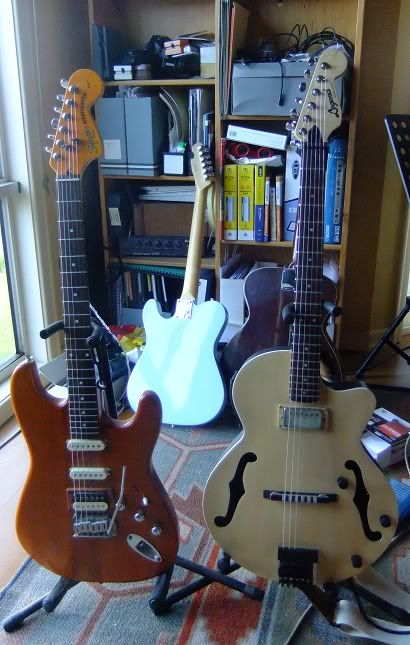 The arch and laid back neck angle, high bridge and thick body make it a different playing experience, but in many ways, especially seated, it is more comfortable and the hands fall more naturally on the guitar. Not quite as comfortable standing. But it is not a 'huge' guitar, about 14" across the body at the widest part. ... Ok, enough from me, housework to do, but appreciate the interest and the collaboration and help, this is a tribute to the help and support one gets here at GN2 without which...etc... |
|
|
|
Post by 4real on Jan 5, 2012 17:43:17 GMT -5
Any difference in current scratchiness between stereo and mono/blend settings? In mono, do you get the same scratch from both outputs or just one output? and when blend is moved? and when volume is moved? In stereo, same questions? If you can step through each part of that carefully, it may be instructive, because going to stereo separates the two halves of the circuit, possibly revealing more of the location of the cause, if it is not just the pots themselves (ps, probably better to stop taking your guitars in the surf from now on) John LOL...ok...you know, every time I plug this in I cant stop playing it and forget what I am testing...I'd not done much of the 'stereo' thing of late...right, so all plugged in... So... volume controlScratchy on both sides. Careful listening does reveal the scratch is slightly different on each side, same sound but two different timings of 'scratch if that makes sense coming from each amp in stereo. In 'blend' mono you of course get both from each side. A lot of turning in this seems to be improving the mag side a at least...I'll keep turning and listening for a bit... Ok, the mag side seems to have pretty much 'gone' for scratch, the piezo side had a fair bit of 'scratch' and just as loud there, even when the guitar is panned all the way to mag and the amp is silent except for that 'scratch' ... odd? The volume pot is plastic and completely sealed...I have a spare, but it means cutting teh shaft and everything of course...just saying. Blend/panTurning the knob a lot in this testing seems to have improved things, possibly some grit or wearing in occurring? The blend control was always a 'slight' scratch though, not anything excessive and now seems to be improving. some more turning...hmmm Ok...so... Now...the 'scratch would appear to be only coming from the piezo side of the signal, the mag side relatively silent of scratch. Obviously in blend mode it comes out both sides, but in stereo only the piezo side. To be 'safe' swapped the amps over sides and yes, the piezo side only on the volume control. Blend/Pan is pretty good now. ... Now don't be such a kill joy...I had actually been considering it...  A small practice amp perhaps, sitting out the back of the cruiser, strumming the guitar to the rhythm of the waves...it's plastic after all, sure it would float. Hmm, perhaps not on the sand though, I am sure the grit would wreak havoc on the trilogy...the volume pot is completely sealed...there is no excuse for it's behaviour! |
|
|
|
Post by JohnH on Jan 5, 2012 18:17:31 GMT -5
Interesting. I appreciate that now the guitar is back togthere, you may not wish to add bits and bobs, but park the followong for next time.
Im blaming the piezo box! (pointing a shaky accusatory finger...), that being the bit I didnt design. A possible (55% likely) candidate for a fix is a capacitor between the piezo output and the blend pot. I think Id use a 2.2uF, with neagitve side towards the pot. That should block any residual dc offset coming out of it. As I say, only slightly greater than even chance of it helping, reTreAd, watcha think?
Also, switch cleaner/lubricant sprayed on the pots and switches does no hard and may help, followed by a few turns.
I appreciate you comment on playing 'Wicked Game', Ive been working on getting this down as a solo piece for quite a while, with no trem in the house!. That first note is key, and the best I do is hold a semitone bend on 3rd string, 3rd fret, then release it and try to move smoothly to the Bm chord.
John
|
|
|
|
Post by reTrEaD on Jan 5, 2012 18:47:06 GMT -5
Seems like an easy enough thing to add, and I'm fresh out of other ideas. I agree with putting the (+) end toward the preamp and the (-) end toward the load, for an electrolytic. But if you can use another type, I'd be more comfortable with that. I've found that electrolytic caps sometimes act peculiar unless they have a DC voltage across them that is at least a reasonable portion of their rated voltage. |
|
|
|
Post by 4real on Jan 5, 2012 20:22:37 GMT -5
Thanks guys, much appreciated...
One thing, the volume pot (the culprit her) is completely sealed...so no way of 'cleaning it' grrr...I have a spare but reluctant you know...if I were sure this was the problem I'd take up your offer of a replacement...but likely try the spare first to be sure.
Fair to think of the piezo. It has it's own volume control of sorts though it has no effect on the noise here...it was not designed for additional pots afterwards I suppose...though it does need to go into an amp which has a pot and preamp stages...so...I don't know there.
I don't recall the piezo always having this noise though, so you know...seems all very odd...perhaps the pot is faulty some how.
I have to say though, it is still odd and most of the noise was coming from the Mag if you recall, and it was working without these symptoms...so...hmmm
(edit...the first post this page I reported no noise from the piezo side, now it is the only place it is bad...hmmm)
...
"Wicked Game"
I've always loved that guitar sound and a classic 'three chord' tune. It always seemed to be an ideal vehicle for a solo piece (is that what you mean to do?) but rarely done for some reason.
I've yet to transcribe things properly, another thing to get on to...but I've always played that tune with some unusual but effective tuning as I seem always to be the only guitar player/singer etc, and tend to play things a little different technically.
But have a go at explaining how it can be done. Of course, all my guitars have trems except this, so I use that for shimmer and sounds best on my tele.
...
chords throughout are Bm-A-E which means you have open strings for the bass for most of the song, though you can also add some bass run back into the Bm chord if clever.
I play it up in the 7th fret, not the original (I assume) open positions.
The first note is clearly that characteristic open B string. You can't dip that without a tremolo really...however...the main effect is that lazy bend into the F#
You can tell I love solo guitar, but there is a lot going on, even in simple things.
So, solo or in a small group, I play out of these chord shapes
Bm 7-x-0-7-7-(0)
A 5-x-7-6-5-(0)
E 0-2-2-1-0-0
This puts the bass on the low string and you should damp that with the heel and try and get that "bom, bom-bom" bass rhythm throughout..not ringing for solo. With a real bass player, not necessary.
The first voicing is one of mine, gives a luxrious minor chord with a doubled third and octave apart with the open D. you need to play this with the 2nd finger on the low string, damping out the A string, 3rd finger on the g string, 4th figer on the b string. Don't hit the high e till needed...
The A chord, I play hendrix style with the thumb, again damping the open A (though it can be useful to use that as the bass note some times, it is an option). The high E doubles the b string E and gives a nice 'ringing' effect like a 12 string and another great voicing...this 'grip' allows for you to lift fingers and such so don't play as a barre chord.
Ok....so...here's a 'trick' to get that opening lick...without a trem...
..........Bm................A..................................E.....
-------|---------------|-----------------------------|---
---0------6b7------------------------5-p-0--------------
-----------7------------------6---------------6---------------
-----------0---------------7----7----------------5 slide----------
--------------------------------------------------------
-----------7----7-7----5-----------5-5----------5------------
..E
----(0)------------------------------(5)-|--------------------------
----(0)----------------------------(5)-----0-----------------------------
----(1)------------2-----------(4)---------------------------
---2-------2s4--------4s2--(4s6)----------------------------------
---2---------------------------------------------------
---0---0-0--------0-0-------------------|-0------------------------------
Ok..so that is the 'tricky' signiture bend...to do this you need to finger the b string 6th fret with the spare 1st finger and pull it down(but not off the fret board or curled up...takes practice and care) while holding and sound the rest of the chord (obviously there is a lot of inner voice stuff that can be added, though you want this 'riff' distinct).
You can see why you need that A grip as you need to pull off to the B and this creates a nice add 2 chord and the melody rings through. It sounds through the change to E and you should milk the slide along the D string.
The E chord has seveal variations, this is typical and nice, the e goes to F# on the D string, then slides back but the melody that moves to A goes up to B...some nice contrary motion. Another 'move' might be to continue up to the higher E inversion instead...(in brackets)
This E will give you the chance to put some vibrato on the B note and that jangly doubled E on top and an upward movement and variety...there are a host of variations of course.
So...having dispensed with the signature 'bend' the main body of the riff does not do this...more like this...
..........Bm................A..................................E.....
-------|-----------0-------|-----------------------------|---
------------7-----------0------------------5-p-0--------------
--------------7------7------------6----------------6---------------
----------------0---------------7----7----------------5 slide----------
--------------------------------------------------------
-----------7-----------------5-----------5-5----------5------------
besides a nice voicing, you can see how this works for the riff melody here, just need to lift that little finger and add in the open E note...all this should ring together in that sultry clash of close intervals...the A chord is essentially the same as before as is the E...
As a solo guitar piece (no singing) you can use this kind of thing to find the melody...
-------------------|----------------------------|------------------
---0-----7-----0-------5---------s3----0--------------------------------
-----6-7------------------b7r6------6-----s2---------4------(2------1-)-
-------------0------------------------------------4s6-----(2s4---4s2---)-----
----------------------0------------0-0------------------------------
---7----7-7--------------------------------------0-------------------
The A and E chords, similar to the riff version. One can get tricky and add some weird country like oblique bends if interested...
in those last too bars, this is a common move of mine...bend to the sus4 A chord and release to the third...slide the E down the B string and let that harp like alternating open and fretted strings then slide into the G# (the riff in brackets answers that phrase and need to alter the dynamics to make it sound different to the 'vocal line'). This is a time where you will want to use the open A for the bass but get a similar damped sound to things.
...
Performance wise, you want to play up those slides and open strings and get a bit of that 'menacing' sound with damped chordal notes added to give a sense of that rhythm as if it is 'snaking up on you' kind of thing that befits the title..but there are lots of things one can do.
You can also use it as a vehicle for soloing on. I see it as a classic 'dorian sound' (though I've had arguments about that). Basically, Bm pentatonic works, add in that C# 2nd which is characteristic and avoid the G# till the E chord and a sense of resolution...the defining Dorian note.
If you solo out of the 7th fret Bm box and return to it, you can bend notes and go all over the place with the A and E chords cause the bass notes are always available. Solo's are not on the record, but they can break it up.
The other parts of the song ("I never dreamed that I'd meet some body like you"), I tend to move it up an octave to the high E string and add some characteristic A6 voicings too...helps to add some subtle colour some times (eg x-0-x-9-7-9)
...
Ok, hopefully this ASCII tab is decipherable. A bit of a free guitar lesson in return for all your work and a different way to play the song (the notes are the same, different techniques).
It is the kind of technique that this guitar was designed to do so kind of on topic...plus a fun tune to play and with the right girl/wife...well, you never know your luck (for some reason, my current GF does not like this song, go figure...who does not like 'wicked game')...I'll have to learn some cold play or something...lacking in melody though so a lot harder to do I find.
...
I still 'improvise' everything, trying to change that by learning arrangements', but this is a classic tune where you can make so many variations as you dare or feel at the time.
I play it the same way in the contest of a three piece band say, but let the bass take the bass line and if singing, more conventional Bm chord with a shimmering vibrato. Tiy can also 'rock it up' with some soul like back beat 'chord stabs' if it is a little too slow or plodding. LOL, I just popped that high E doing that then as with my new technique such things are done with the back of the middle and 4th fingers backwards using the back of the nails as a kind of 'flick'...not as controlled as a pick clearly. Oh, with others I always played this with a pick and hybrid picking...might be tricky to get the right sound picking everything without the fingers, never tried it!
...
Again, may thanks...let me know how you find this kind of approach to this song.
|
|
|
|
Post by JohnH on Jan 5, 2012 22:52:10 GMT -5
Thanks for the Wicked advice and im going to study it carefully. I'll know when I've got it right when the ladies start throwing underwear at me. (at the moment it's still shoes and fruit, but I'm used to that)
Just one small question on the first note (gotta start somewhere). If the first bent note was originally an open B tremied downwards, how is that replaced by fretting the B string at the 6th bent to 7th? i may have the wrong end ogf the stick
My aim is to play and sing, picking up chords overlain by the guitar solo. I got lucky finding what I think I need with Bm in the 2nd position and open A and E, and finding melody notes with lift-offs and additional notes with spare fingers.
cheers
john
|
|
|
|
Post by 4real on Jan 5, 2012 23:43:09 GMT -5
Oh....well...
There is a 'scoop' like surf move of a 'dip' on that open B...however, the most distinctive bit is that open string sound followed by the slow release up to the F#...sing it to yourself...or better yet...
...includes a half naked model for inspiration...and Chris's turned up nose...so you are saying I can't play this guitar in the waves there?
Right, having watched that...
Yes, there is a long slow (1/2 step, surf style) dip...if you dare...play the open B and bend the neck or headstock...however...
For a solo guitar, you don't have the luxury of that nice spare accompaniment and want to get the tune across as well as that riff on your own. I of course have trem guitars precisely for this sound and my tele sound exactly like that.
Failing that move...and on your own...you cant do the dip, but you can get the open B and bending up into the F# gives the effect of the release of that dip. Fingered like this, it allows for you to play the chords, bass and the riff. Most audiences will 'hear' that dip when the tone of the open string and rise into the F# is heard as a substitute...try it...
Obviously, though the notes are the same, if you don't have a trem, or if you are playing this and the accompanied part on your own, there has to be some compromises.
I have not heard the original for a while...there is a characteristic F# to open B slide off of the A chord...just sub that using your little finger where it appears. Again, another reason to play the A up there and in this style.
Even better if you are singing it...once the guitar chores are over, I just use the same chords but a more usual Bm7th 7-x-7-7-7-7 , not as good without the shimmery trem, but does the job.
A on the 5th fret with that doubled B will give you more of a sense of that 'echo-y' sound, even on an acoustic on the beach, with the girl and...right...and played up here sounds a lot better than the intonation poor open A chord on the second fret (a notoriously 'out of tune chord') which will really show in this song if it is out.
Snatches of that riff on the E chord can be included easily as a call and response to the lyric. I am used to hearing a bass line off the E...possibly an invention of the bass player I was playing with (there's not a lot to do for the guy, LOL) that walks up 0--2--4--0 to Bm and can easily be included on the last bar of E in quarter notes and the high open strings ring over it.
The original is largely played in the open position, though it has to go up to the higher frets really on occasion. Unless you have the falssetto of Mr Isaacks and those embroidered suits he wears, the male voice sits in a similar range of the lower chords and to me works better when playing without a band to include a wider range chord like the Bm7...
But hey, got the transcription around somewhere, but not a 4 piece band to accompany me...LOL
Definitely a good one to learn to do a bit of hybrid picking...
take what you like and leave the rest...and/or get a strat and learn all those great subtle surf-a-billy trem moves...it is a great song though...enjoy
EDIT...I'll make a point of playing a few snatches when I demo this guitar...text is hard to explain of course...but hearing is believing LOL...there are a tone of 'fancy touches one can do...all the natural harmonics fit perfectly on this sequence and from this way of playing...but then, this is a part of my evolving unorthodox style and 'sound' while still carrying the tune...well, that's my excuse!
|
|
|
|
Post by thetragichero on Jan 6, 2012 2:19:44 GMT -5
i think what they were getting at is the filtering from the power supply, so splicing in the electrolytic cap where they suggested (with alligator clips and test leads like they suggested) would be a good test to start off with
if it doesn't help then some soldering and heat shrink would repair it pretty ably
|
|
|
|
Post by 4real on Jan 6, 2012 2:42:17 GMT -5
Thanks...yeah, I kind of get the idea and will try it next time I take my guitar apart...I miss it and the dining table every time I work on the thing...but each time little improvements. It is not an 'easy' guitar to get into you know LOL! ... On island news... I went to the super market today to stock up and parked between a masseratti and a porsche...clearly out classed... But...better than that if of the car aficionado type is this weekend... It's the Kustom Nats where all the hot rodders invade the island for three days of revving motors, lowered car and chrome and tattoo'ed ladies.. oh...and cars...lots of shiny cars...and what goes with cars...20 bands of rock-a-billy all day, everyday LOL...   clearly I like the natural beauty of the surfer chicks...or is that just because they wear next to nothing and get wet...but you got to like enthusiasm, so me and the GF (who, come to think of it has a couple of little tattoos...hmmm)....will be going and checking it out... ... The guitar is getting there and the 'surround sound' really is a lot of fun to play. I forgot to thank John for the plan on the 'stereo switch' which is simple but so effective. It is often good to have it in blend through both amps and use that control like a tone control...or to switch to a stereo mode with the sound split and able to pan between them...much better than my idea of not having a switch some how and using the jack sockets to be an either or kind of thing. It's quite an experience having the guitar come from all over rather than a speaker in the corner and the amount of tonal variation possible is startling with two amps...you can even move the sound back and front if you use different reverb settings on the amps...cant wait to try and few 'effects' out on this system...I feel a 'pedal board' coming on and a specialist lead...especially when i get the patience to attempt the 'Hex' system... Now, where did I put that temporary tatto I was saving for a special occasion... |
|
|
|
Post by gumbo on Jan 6, 2012 6:51:05 GMT -5
...oh, you mean that tattoo that says..
"Yes, I AM playing a real guitar... "
;D
|
|
|
|
Post by ashcatlt on Jan 6, 2012 10:32:42 GMT -5
I'm pretty well lost at this point as to what actually went into the guitar, but...
The cap that John and retread were talking about most recently is not for power filtering (which could also be called de-coupling) but for blocking DC leakage from the piezo (AC coupling). The decoupling cap would go in parallel with the power supply, and shouldn't be necessary on a battery fed device. The coupling cap goes in series with the "hot" signal output from the piezo preamp.
It almost makes sense to me that a DC voltage there would cause some of the symptoms. When turned all the way to mag, it might change the potential of the "ground" of the system, causing the dark cap to suddenly charge or discharge to compensate. Thus that thump. I can't imagine that whoever built that preamp would have left such a thing out, but they may well have used a cap which was cheap and displays poor leakage properties. I was wondering if maybe a "pulldown" resistor after the piezo output wouldn't help to hold that end of the cap at ground.
|
|
|
|
Post by 4real on Jan 6, 2012 17:02:28 GMT -5
...oh, you mean that tattoo that says.. "Yes, I AM playing a real guitar... " ;D LOL... can one make your own temp tatt? I think mine would read Yes, I AM playing a plastic guitar... I found it, it has some kind of 'skull' on it I'm sure. There are tattoos, and there are tattoos of course...  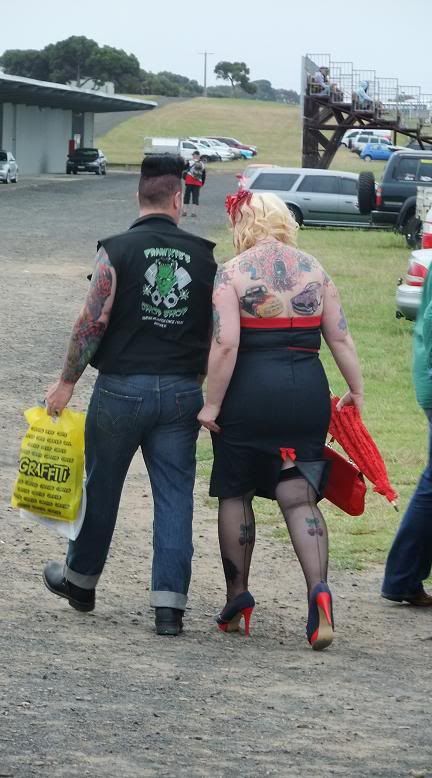 I guess I prefer the beach babes...LOL...I know I'd regret anything I wrote on me permanently... ... Yeah, there are some odd things going on, it could be something 'silly' I did not replace the volume pot this time for instance. There are a few odd things going on but perhaps I need to put more time on the guitar to really get a feel for what is going on as 'normal' 'cause really, there was no problems with the piezo side of things earlier it seems, now there is...all problems were on the mag side, now it isn't. The wiring as you can see is a bit all over the place, but there are no cold soldering joins or anything and I've tried taking things superfluous stuff while maximising the shielding and it is a very quiet guitar. I did notice yesterday that the little volume control on the piezo seems not to be doing much...however I can't recall if that control adjusted all the way down to zero...but another 'suspicious' thing going on there...odd. Still, it is a great sounding guitar and playing better for the work the last week on it and several hours playing in as well...hard to put the thing down once I pick it up which is a good sign for any guitar. But, weekend here, 31C with a cool sea breeze, Hot Rod show in town, GF coming down for a few days...sky is blue, water is bluer... 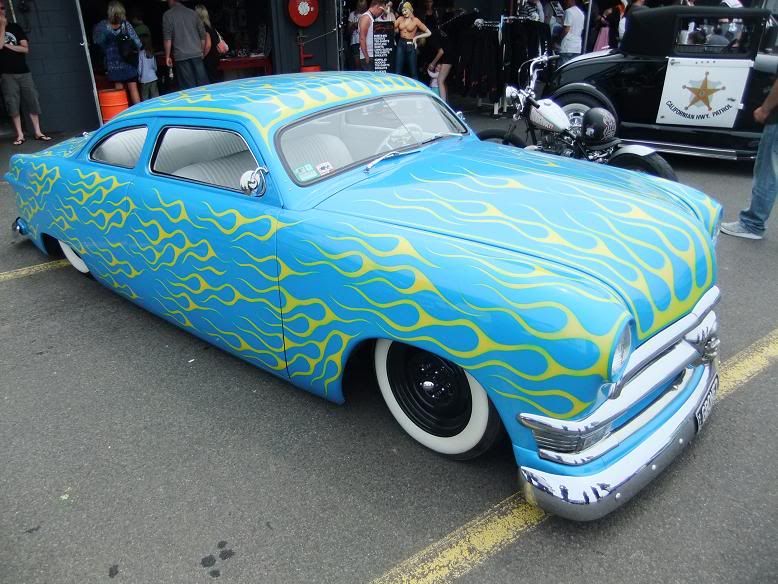 Maybe I will see something to inspire a new guitar... |
|
|
|
Post by gumbo on Jan 7, 2012 3:27:53 GMT -5
4real wrote: Maybe I will see something to inspire a new guitar... .....well, at least there's bound to be acres of plastic on the Island  |
|
|
|
Post by 4real on Jan 9, 2012 5:17:19 GMT -5
.....well, at least there's bound to be acres of plastic on the Island  Well, don't quite know what that means...however...I did see quite a few things...this for instance is likely good advice to all... 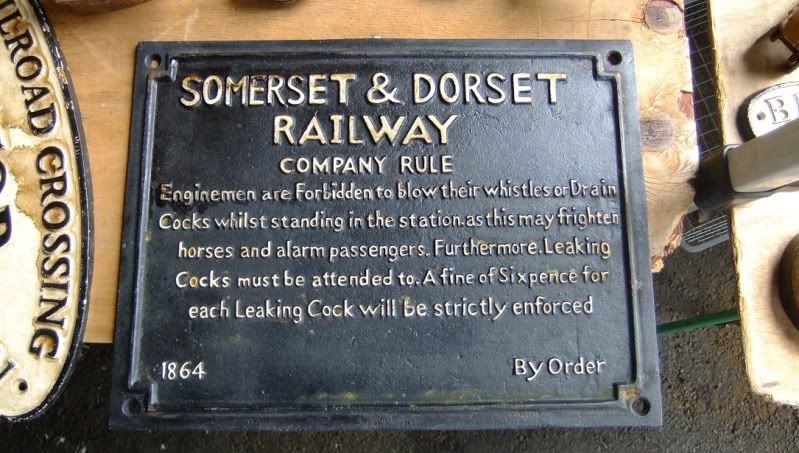 and then again, it is the details that matter often...subtle things like this hood handle for instance...I need som ideas for stowing the trilogy's little allen key... 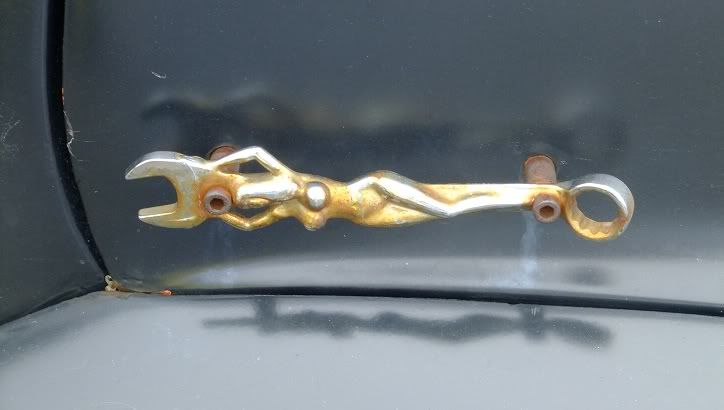 Australian's will be well familiar with this make of car... 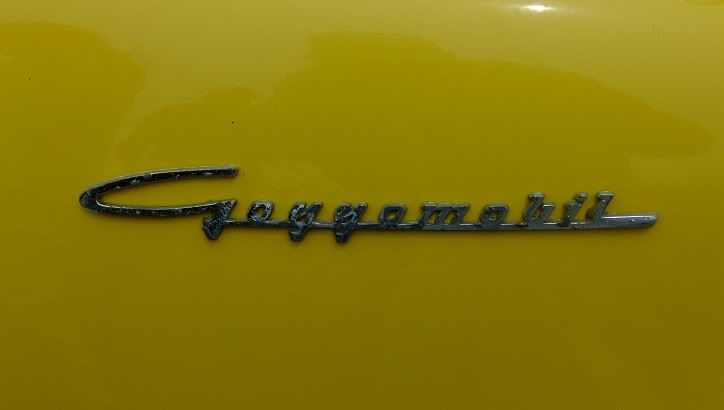 go-ggo--- But I digress, very little plastic...betty boop with tatts was the look for women this year, standard hair grease for the guys...a lot of love gone into the cars plus a sense of humour. Leopard skin is in again, dresses and interiors alike...either make it shiny, or a little rusty...music, rocakabilly and there was a great guitar player on hand with a vintage P-90 gibson hollowbody that sounded top-notch! ... There though is a pic my GF took (should not have encouraged her to take photos perhaps) of me playing, a very rare thing, and showing how 'vigorous' this new kind of fingerpicking technique I am trying to develop can get... 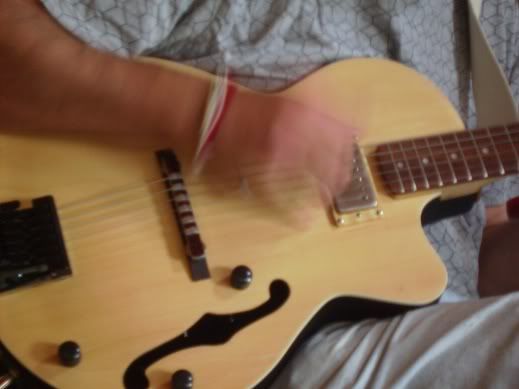 It involves the thumb primarily for the bass and trying to incorporate a fewll slap and pull techniques from bass which works well if done close to the bridge though hard to incorporate with other elements. The 'strum' thing is typical on beatrs 2 and 4 and kind of related to flamenco technique in a way, got it from Jake Riechbart's style...it uses a kind of wrist flick and strum using the back of the 2nd and 3rd finger nails. I use flesh for teh picking but have the nails enough to do this thing and adds 'variety' into the overall texture. It is no wonder though that the High E pops off occasionally till I get this more under control. The GF is the first to hear the guitar in person (other than the neighbours and wildlife here) also and was suitably impressed, she knows I've spent a bit of time on this so could be biased. She loved the huge stereo sound (but she like loud music) and commented that the guitar sounded really 'crisp and clear'..but I did notice she liked a sound with a bit more 'grind' from the fender and it does this quite well to while still giving decent separation. Both piezo and mag sounds are good, the blend perhaps could work better and perhaps consider a rebuild with the stew-mac pots when they come in some time with a different scheme. As it is, the mag sound, with a little piezo is the sound I envisaged and works best I think...very low noise, a good body and some nice harmonics and percussive edge to things. |
|
|
|
Post by gumbo on Jan 9, 2012 5:39:50 GMT -5
...nice one! ..for "acres of plastic' , read "bog".....  |
|
|
|
Post by 4real on Jan 9, 2012 5:55:42 GMT -5
Ahhh...bog...well, there may will have been a bit of filler, but did not feel inclined to feel the body work as security was being handled by the keysbourgh roller derby girls on skates...no, I am not kidding!
|
|
|
|
Post by JohnH on Jan 9, 2012 6:07:11 GMT -5
Over the last few days, Ive been thinking of some different ways to address the issues with your circuit.
Switch on thump
Before anything is switched on, all parts of the circuit at a ground level electrically, then when power is applied, the source connection on each buffer JFETquickly rises to about 5V, and this makes a thump on the output, which decays back to zero as the output cap fills up. 5V is a big spike and is no doubt somewhat noisy!
Ideas:
1. There is a 1.5M resistor on each output cap who’s job it is to bring the cap output back to ground. This will take several seconds, and it could be made faster with a smaller value resistor, say 100k to 220k instead of 1.5M. Still a big spike though.
2. The bias resistors on each buffer (the two 3.3M’s), which bias the JFET input to 4.5V could be replaced with a different arrangement and starts low and charges up, hence keeping the output lower and cutting down the thump
3. The power to the buffers could be supplied via an extra circuit (one transistor, one resistor and one cap) that will cause it to rise slowly at switch on instead of suddenly be at max, hence giving the output more time to adjust
4. Have an extra power switch on the guitar, (which I think you wanted anyway), which will allow the power to be disengaged while still plugged in, but also have a centre position where the output is grounded to keep it quiet, but power is on, so all caps are getting charged up. So when you go to full ‘ on’ there’ s no thump. It would be a dpdt on/on/on (unfortunately rare in Aus, do you have any?). It would still rely on the jack switch, so if no plug pushed in, no power to the guitar. In use, it would be like this:
Down: power is off, output is grounded no power and no sound
Centre: power is on (caps charging), output still grounded (so cap fills fast – maybe via a resistor) so no sound and no thump
Up: power is on, output is on, no thump if a couple of seconds has been spent in centre position.
Out of all those, 4 would be a pretty easy and useful work around, but for the future I might try 3 and 2.
Use of 100k volume pot
The 470k’s seem not to have been so great, but to replace them with 100k will cause a worse blend dip at mid blend.
Could put the 100k volume pot right on the output, after instead of before the output buffers. This will also allow the jacks to be inserted with no thump, if you zero the pot before inserting the plug (even without the de-thump ideas above). It will also take load off the blend pot, so the current blend pot will have less central dip. The possible downside is if yuu drive a low-impedance mixer line-in, you need to turn up more. You can test the use of 100k pots at the output externally, just by setting the guitar as currently wired to max volume, and wiring up a 100k pot outside the guitar with alligator clips etc, then you can listen for scratch, test the taper etc. Best to test it with a mixer too if possible
Cheers
John
|
|
|
|
Post by 4real on Jan 9, 2012 6:42:27 GMT -5
Thanks john...some interesting ideas...will consider them more as I put them to use. Played the guitar for many hours today...looks behind me...yep, left it plugged in again...thanks for the reminder! I think if there was an 'off switch' I'd be looking for some kind of 'slide' switch on the output jack plate perhaps. Might be easier to find an on-on-on too. Not entirely sure, was running through my mind about possibilities for a hex thing...yes, I have not forgotten...and perhaps making such a device 'stereo'...a power on separate from the jacks might be advantageous there, will have to see how things pan out in that department. ... Oh no, I was thinking, see how these 500k mix pots with centre indent look and work. Perhaps one of the earlier schemes with a similar function but with the 100K volume before a 500K blend might suit...I believe there may ahve been something that fits this bill. For the record though, a 'de-thump' option would be advantageous I believe and some may well want to use a conventional socket with a 'stereo' plug making ground switching impractical and some kind of de-thump circuitry advisable perhaps...from a design point of view, it could be an advantageous option for others down the line. ... No mixer as such, though the computer interface is low-z so that might be a test yet to do. There is no 'hurry' on any of this as the guitar is sounding great and these things are largely 'niggles' that I would like to fix in time with a cohesive plan rather than patchwork and addressing a few of these 'issues' like the 'thump'. Running in stereo, I am using two leads to amps a fair way apart, eventually to a pedal board, perhaps three leads with the hex on a multi core cable. Such a set up is not really 'easy' to unplug everything for each 'break' in playing. Overall the scheme works well, the dark switch on one pickup system is a real winner and worthy of nutzy consideration on any guitar I think. ... I have played it for many hours though and the battery is fine as far as I can tell. oh, and on the thump thing, your prognosis seems correct, when it is plugged in for mono and you insert another jack, there is not 'thump' or noise at all...so, things are obviouslyu' charged up' in there...hmmm. ... Here's a pic of a car with a similar 'go' button as being proposed...see, these events can inspire... 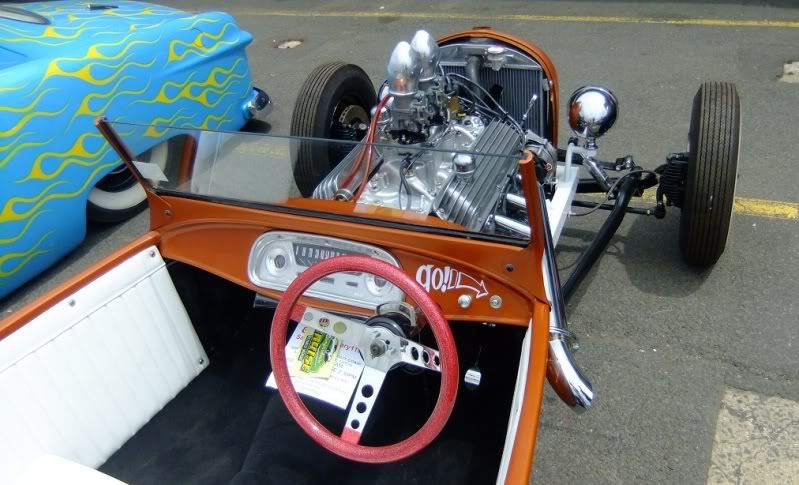 |
|
|
|
Post by 4real on Jan 10, 2012 5:17:37 GMT -5
Putting the hours in playing the guitar...a great tool and quality sound...still like a little better performance from the electronics... On that, the stew-mac 'blend pot' came in...x2... www.stewmac.com/shop/Electronics,_pickups/Potentiometers/Blend_Pots.html?tab=Instructions#details I can report that from the centre indent, it goes to 500K in one direction and zero throughout the turn the other way and the opposite on the other gang. The result is that the centre is zero and this makes some sense. If such a large pot is a problem on the rear end, previous schemes had this before the volume which seems doable to just simply reverse the schemes with say a 100K dual gang (lin/log?...I have a linear on hand) and then out...or in fact any appropriate value. Not about to do it right now but got a better idea about things through this process and the potential of the guitar. So, perhaps some 'de-thump solutions' and power switching might be something to consider. Generally though, it does not seem to be using a lot of power being switched on a played for many hours lately. The fail safe is to always have a spare battery of course. Still, although the volume pot might be scratchy, there is no noise unless it is moved and sounds great. The dip in volume in the blend is a little distracting as I am sure there is some magic there, generally I am playing largely the magnetic side. "Flat EQ' the piezo has a bit of 'quack' but this can be tamed rather well with the EQ and blending in a bit of Mag. The mag actually sounds a bit like an acoustic's sound hole pickup, has a kind of woody sound to it. I've been thinking of trying flat wound strings, but they don't seem to make them in a heavy bottom/light top (10-52 with a plain third) as I can get a little too much finger squeak...any thoughts on the nanoweb strings for instance as an alternative?  |
|
|
|
Post by JohnH on Jan 10, 2012 6:11:26 GMT -5
Hi Pete - my best attempt at a design using the Stewmac pot was this:  But it has some potential hairs on it, such as it will be louder in middel than at ends, and the blend will be very sensitive as you turn away from the detent, one signal will probably quickly drop away. In blend mode, turned fully to one pickup, it is only half the full volume from that pickup. But before going too much further, how about a couple of samples. I know youll entrance us with your playing, but also some test signals, such as a simple lick or strum, played at say four steps of blend from all mag to all piezo. Id be intersted to asess the dip in the middle. If the mag is relatively powerful, maybe set it to parallel mode? Another question is, is the volume pot scratchy when moved, when there is no sound signal, or only when moved when the guitar striings are sounding? - it is a clue to whether ther eis dc leaking through the pot. cheers John |
|
|
|
Post by 4real on Jan 10, 2012 6:19:24 GMT -5
Thanks John...
will try and do a sound clip in the near future, nothing fancy, soundclick is such a bugger to work with I find...sigh....
Otherwise, yes the noise is the same with and without sound. Parallel sound does even things up a bit for the blend. Oddly, the piezo volume does not seem to have the same kind of effect...will have to check that tomorrow perhaps.
Half volume does not sound like a good thing...hmmm...so perhaps it is best to persevere.
|
|
|
|
Post by gumbo on Jan 10, 2012 7:55:11 GMT -5
...hmm.. ...as to the earlier comment about Elixir Nanowebs, check out eBay seller "Dr Cluck" ...nice to deal with, reasonable prices, and ships well to Oz.... ...I get a good run on electrics out of these.. actually running 10-52s on the Roland Ready Strat...  gumbo |
|